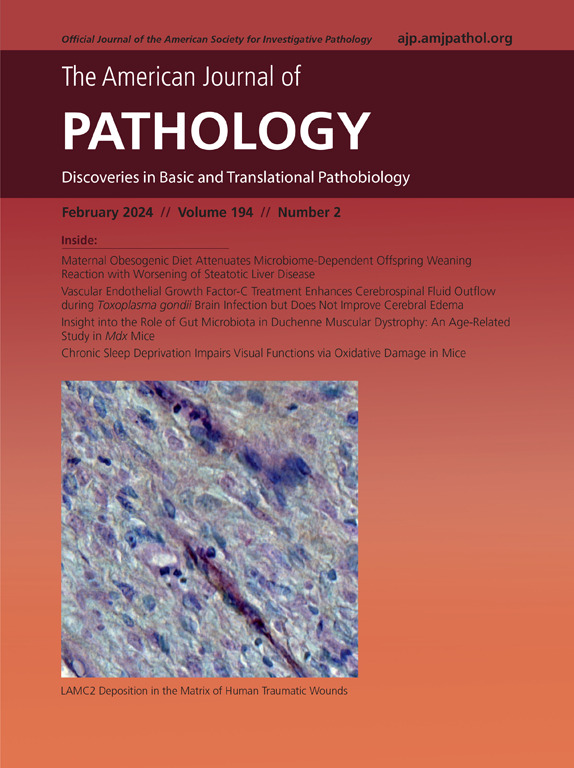抑制固醇调节元件结合蛋白(SREB-P)SREBF-1可克服晚期前列腺癌对多西他赛的耐药性。
IF 4.7
2区 医学
Q1 PATHOLOGY
引用次数: 0
摘要
对抗雄激素和化疗(Cx)的抵抗限制了激素敏感性前列腺癌(mHSPC)和激素抵抗性前列腺癌(mCRPC)患者的治疗选择。在这种情况下,糖皮质激素受体(GR)的上调被认为是mCRPC的一种潜在旁路机制,多西他赛和GR抑制剂米非司酮(Doc + RU-486)的组合能使多西他赛耐药细胞模型对Cx重新敏感。 本研究旨在阐明造成这种现象的分子机制。在多西他赛+RU-486治疗后,对多西他赛耐药的PCa细胞模型进行了RNA测序(RNA-seq),并进行了连续的功能测试。在疾病进展期前列腺癌(PCa)患者的前列腺组织中验证了所选蛋白质的表达。RNA-Seq发现,胆固醇和脂质生物合成的转录因子--固醇结合转录因子1(SREBF-1)是一个显著下调的靶点。功能测定证实,SREBF-1 的下调是造成这一观察结果的部分原因。同时,SREBF-1敲除和药理 SREBP 抑制以及胆固醇途径中的其他关键酶也显示出相似的结果。此外,SREBF-1 在晚期 PCa 组织中的表达明显升高,表明它可能参与了肿瘤的进展和新出现的耐药性。因此,对胆固醇和脂质生物合成的特异性抑制也可能针对Cx耐药的癌细胞,是未来改善mCRPC治疗的一种潜在附加治疗方案。本文章由计算机程序翻译,如有差异,请以英文原文为准。
Inhibition of the Sterol Regulatory Element Binding Protein SREBF-1 Overcomes Docetaxel Resistance in Advanced Prostate Cancer
Resistance to antiandrogens and chemotherapy (Cx) limits therapeutic options for patients with metastatic hormone-sensitive (mHSPC) and metastatic castration-resistant (mCRPC) prostate cancer. In this context, up-regulation of the glucocorticoid receptor is identified as a potential bypass mechanism in mCRPC. A combination of docetaxel and mifepristone (Doc + RU-486), an inhibitor of the glucocorticoid receptor, re-sensitizes docetaxel-resistant cell models to Cx. This study was designed to elucidate the molecular mechanisms responsible for this phenomenon. RNA sequencing was performed in docetaxel-resistant prostate cancer cell models after Doc + RU-486 treatment with consecutive functional assays. Expression of selected proteins was verified in prostatic tissue from prostate cancer patients with progressive disease. Treatment with Doc + RU-486 significantly reduced cancer cell viability, and RNA sequencing revealed sterol regulatory element of binding transcription factor 1 (SREBF-1), a transcription factor of cholesterol and lipid biosynthesis, as a significantly down-regulated target. Functional assays confirmed that SREBF-1 down-regulation is partially responsible for this observation. In concordance, SREBF-1 knockdown and pharmacologic sterol regulatory element binding protein inhibition, together with other key enzymes in the cholesterol pathway, showed similar results. Furthermore, SREBF-1 expression is significantly elevated in advanced prostate cancer tissues, showing its potential involvement in tumor progression and emerging therapy resistance. Therefore, specific inhibition of cholesterol and lipid biosynthesis might also target Cx-resistant cancer cells and represents a potential additive future therapeutic option to improve mCRPC therapy.
求助全文
通过发布文献求助,成功后即可免费获取论文全文。
去求助
来源期刊
CiteScore
11.40
自引率
0.00%
发文量
178
审稿时长
30 days
期刊介绍:
The American Journal of Pathology, official journal of the American Society for Investigative Pathology, published by Elsevier, Inc., seeks high-quality original research reports, reviews, and commentaries related to the molecular and cellular basis of disease. The editors will consider basic, translational, and clinical investigations that directly address mechanisms of pathogenesis or provide a foundation for future mechanistic inquiries. Examples of such foundational investigations include data mining, identification of biomarkers, molecular pathology, and discovery research. Foundational studies that incorporate deep learning and artificial intelligence are also welcome. High priority is given to studies of human disease and relevant experimental models using molecular, cellular, and organismal approaches.

 求助内容:
求助内容: 应助结果提醒方式:
应助结果提醒方式:


